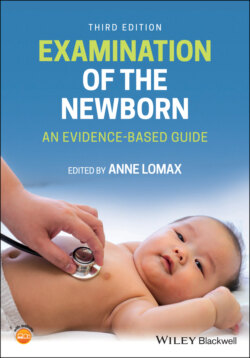Читать книгу Examination of the Newborn - Группа авторов - Страница 32
The fetus in focus Fetal anomaly screening
ОглавлениеUltrasonography in pregnancy is part of the NHS Fetal Anomaly Screening Programme (FASP) (PHE 2018b). Two key ultrasound scans are offered as a minimum standard. The first scan is the early dating scan. It is therefore important to note the gestational age of the newborn from the dating ultrasound scan result prior to conducting the examination.
The second is the 18+0 to 20+6 week fetal anomaly scan (PHE 2018b). Additional serial scans will be performed if an abnormality or abnormal fetal growth is detected, either with the fetus or with the intrauterine environment, e.g. liquor volume or placental positioning. Fetal growth estimation is the primary parameter assessed. The Royal College of Obstetricians and Gynaecologists (RCOG) provides a green‐top guideline (RCOG 2013) and the Perinatal Institute offers guidance on fetal growth and the use of growth tools during pregnancy to monitor fetal growth that can be found at http://www.perinatal.org.uk/FetalGrowth/fetalgrowth.aspx.
TABLE 1.3 Using the maternal obstetric records, newborn records and NHS Antenatal Screening Programme results to create a history profile.
| Creating a history profile | |||||
|---|---|---|---|---|---|
| Maternal medical history | Antenatal screening results | Pregnancy and labour history | Family history | Psychosocial factors | Newborn |
| General health status | Serology reports | History of diabetes | Smoking | Resuscitation at birth and time to response | |
| Cardiac disease | Rhesus status | Incidence of infection and bacteria isolate | Intergenerational conditions | Substance use | Method and frequency of feeding |
| Renal disease | Prenatal screening positive test results | Pathologies, e.g. pre‐eclampsia, placental insufficiency | Inborn errors of metabolism | Alcohol dependency | Passage of urine and meconium |
| Hypothyroidism | Prenatal diagnostic investigations | Mode of delivery and presentation | First‐degree relative with CHD | Depression or mental illness | General health and behaviour since birth |
| Gestational or type 1 diabetes | Prenatal diagnosis of a cardiac abnormality | Pre‐labour length of membranes rupture | First‐degree relative with DDH | High‐conflict relationship | Presence of meconium at birth or risk or early onset sepsis |
| Nutritional status and BMI | Prenatal diagnosis of a trisomy | First‐degree relative with a childhood eye condition | Safeguarding issues with siblings | Parental concerns | |
| Depression or history of mental illness | Ultrasound growth scan profile | Social services involvement with family | Symptomatic of illness |
Evidence of intrauterine growth restriction is not an uncommon finding There may be evidence in the maternal history that may indicate why the newborn is small for gestation age. There may be a pre‐existing maternal medical condition that has adversely contributed to placental function resulting in a poor fetal growth profile. Fetal growth restriction may be a feature of an underlying chromosomal abnormality or other pathology, e.g. transplacental viral transmission or the effect of a toxic substance, such as alcohol excess in pregnancy. Further information on the NHS FASP can be obtained from the website: https://www.gov.uk/government/publications/fetal‐anomaly‐screening‐programme‐handbook.
The NHS FASP (PHE 2018b) outlines the conditions screened for at the anomaly scan. Whilst it is useful in many cases, it is prudent to accept that this scan does have its limitations; therefore, the focus lies with a standard for 11 structural conditions where the specificity for detection is greater than 50% (PHE 2018b). Conditions screened for are as follows:
Anencephaly
Open spina bifida
Cleft lip
Diaphragmatic hernia
Gastroschisis
Exomphalos
Serious cardiac anomalies
Bilateral renal agenesis
Lethal skeletal dysplasia
Edward's syndrome (trisomy 18)
Patau's syndrome (trisomy 13). (Adapted from PHE 2018b.)
The presence of other findings is significant and, as such, is reportable by the ultrasonographer as listed:
Nuchal fold (greater than 6 mm)
Ventriculomegaly (atrium greater than 10 mm)
Echogenic bowel (with density equivalent to bone)
Renal pelvic dilatation (AP measurement greater than 7 mm) (PHE 2018b).
Fetal renal pelvic dilatation will require serial scan monitoring throughout the pregnancy. However, it is particularly important to note this during history taking and to arrange follow‐up ultrasound scans and urology clinic referral for the newborn.
The presence of oligohydramnios must alert the NIPE practitioner to the possibility of the following:
Prolonged rupture of membranes earlier in the pregnancy
Urinary tract anomaly or uropathy
Fetal growth restriction (Baxter et al. 2010)
Intrauterine infection.
Conversely, polyhydramnios will alert the examiner to consider the following:
Duodenal atresia or stenosis (Rajiah 2009)
Oesophageal atresia.
Exposure to the effects of intrauterine teratogens has been investigated and publicised over recent decades, but arguably the most common causes of such exposure is smoking and excessive alcohol consumption during pregnancy.
